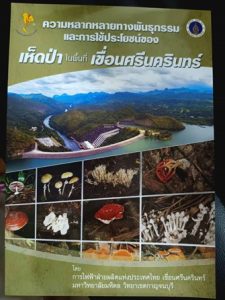Genetic diversity and utilization of wild mushrooms in Srinakarin dam
Highlight:

- Srinakarin Dam has a diverse range of mushrooms. Based on field surveys, we collected 209 samples of wild mushrooms, primarily prevalent in October, for examination.
- Forty-five samples were identified as edible mushrooms, and 33 samples were classified as medicinal mushrooms.
- Five samples of poisonous mushrooms were identified, some of which bear a resemblance to Termitomyces sp., which are well-known edible mushrooms of Kanchanaburi province.
- We discovered Gyrodontium sacchari, a globally endangered species belonging to the tooth fungus category.
- Various native Ganoderma mushroom species were found, showing potential for further research into their medicinal properties. Previous researches indicate that mushrooms within this group, known for their economic significance, possess medicinal properties and can be utilized in the treatment of various diseases.
Researcher Name: Prapapan Sawhasan Chuthamas, PhD.
Years of execution: December, 2018 to March, 2021
Funder Name: Electricity Generating Authority of Thailand (EGAT)
Objectives:
- To study the genetic diversity of wild mushrooms in the area of Srinakarin dam.
- To identify species of wild mushrooms using DNA barcoding of nuclear ribosomal Internal Transcribed Spacer (ITS) region.
- To gather information on the potential uses of wild mushrooms as food, medicinal fungi, and identify poisonous mushrooms that may pose a danger in the Srinakarin dam area.
Abstract
Srinakarin Dam is an area rich in natural resources and has a high biological diversity. Mushrooms are biological resources in the forest that can be used as food and medicine. Nonetheless, some mushrooms can be dangerous if consumers mistakenly believe that poisonous mushrooms are edible mushrooms. The aim of this research is to study the genetic diversity and utilization of wild mushroom in Srinakarin Dam. Field surveys were conducted from January 2019 to October 2020. Wild mushrooms were collected for morphological identification and ITS sequencing. According to the field surveys, 209 samples of wild mushrooms which can be found mostly in October were collected to examine. The results show that 209 collected mushrooms could be classified into Phylum Basidiomycota for 186 samples (89%) and Phylum Ascomycota for 23 samples (11%). Furthermore, the identified mushrooms were classified into 14 orders, 34 families and 68 genera. The most common orders and families were Agaricales (76 samples) and Polyporaceae (69 samples), respectively. The mushroom utilization was categorized into 4 groups; edible, medicinal, poisonous, and unknown utilization mushrooms. Edible mushrooms could be identified in 45 samples while medicinal mushrooms were found in 33 samples. Five samples of poisonous mushrooms were established, and 126 unknown utilization mushrooms were discovered. The most common genera were Garnoderma (20 samples) which was the medicinal mushroom. In addition, the mode of nutrition was classified into 2 groups including saprotrophic fungi in 185 samples and mutualistic fungi which consisted of mycorrhizal fungi in 16 samples and Termite mushroom in 8 samples.
Reference: Genetic diversity and utilization of wild mushrooms in Srinakarin dam
Published document / 2022
